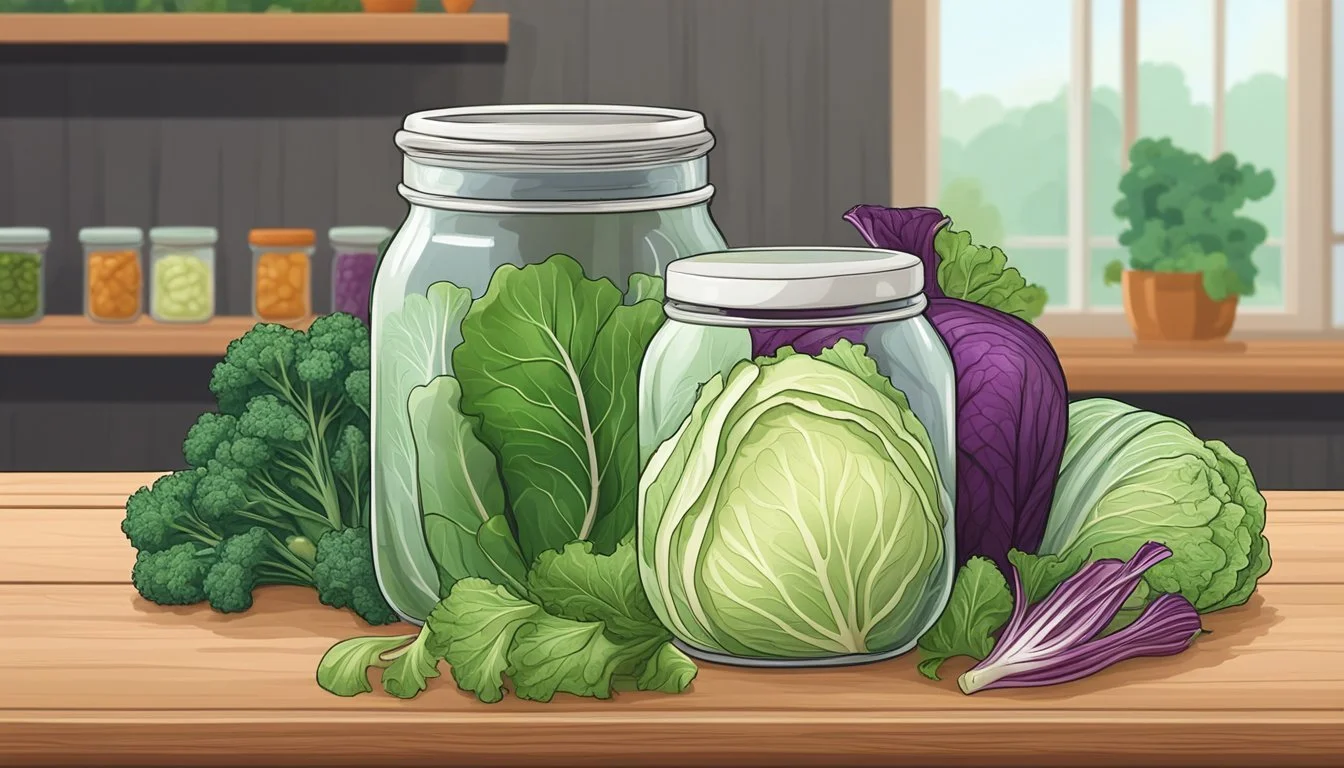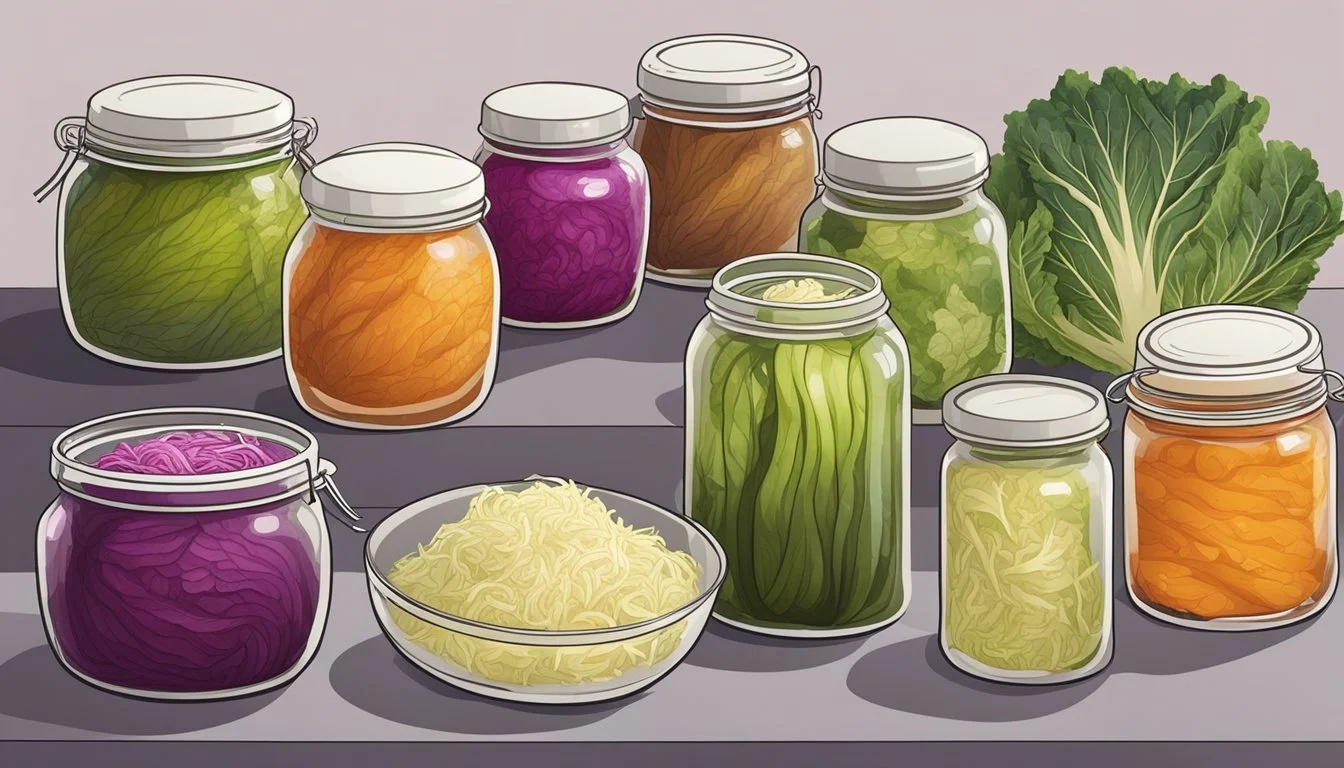Pickled Cabbage Substitutes
Top Alternatives and How to Use Them
Finding a suitable substitute for pickled cabbage can be crucial when you want to maintain the specific flavor profile and nutritional benefits it offers. Kale and Bok Choy are excellent alternatives due to their similar texture and vitamin-rich content. These substitutes not only provide a crisp, tangy flavor but also come packed with essential nutrients, ensuring your dish remains both delicious and healthy.
For those looking to replicate the briny, slightly sweet characteristics of pickled cabbage, Napa cabbage and Brussels sprouts offer a comparable taste. These vegetables absorb pickling flavors well and can easily fit into various recipes that call for pickled cabbage. This way, the overall integrity of your meal stays intact, even when the main ingredient is swapped.
On the other hand, if texture is a top priority, Iceberg lettuce and Endives can also do the trick. Though they might not exactly match the distinctive flavor of pickled cabbage, they add a refreshing crunch that works well in salads and toppings. Incorporating these substitutes ensures you don't miss out on the enjoyable bite that pickled cabbage typically provides.
Understanding Cabbage Substitutes
Choosing the right cabbage substitute depends on various factors such as flavor, texture, and nutritional content. Consider these aspects carefully for best results in culinary applications.
Characteristics of Cabbage
Cabbage offers a crisp texture and slightly peppery flavor. It comes in several varieties including green, red, and Savoy. Each has distinct attributes, such as red cabbage having a vibrant color and Savoy cabbage having a tender, wrinkled texture.
Nutritionally, cabbage is rich in vitamins C and K, and contains fiber, potassium, and antioxidants. Its versatility makes it suitable for dishes like salads, stir-fries, and soups.
Criteria for Substitute Selection
When selecting a cabbage substitute, prioritize similar texture and flavor profiles. For instance, bok choy and kale closely match the crunch and taste of cabbage. Nutrient content is also crucial; options like Brussels sprouts and napa cabbage offer comparable vitamins and minerals.
Consideration of color might be important too; iceberg lettuce could work for a green hue, while red cabbage alternatives might include beetroot for a striking appearance.
Knowledge of these factors helps in making an appropriate selection for any culinary need.
Top Cabbage Substitutes
When making pickled cabbage, several substitutes can be used to achieve similar textures and flavors. Options range from leafy greens to non-green vegetables and even fruit-based alternatives.
Leafy Greens as Substitutes
Kale is a nutrient-rich option with a slightly bitter taste. It holds up well in pickling and offers vitamins A, C, and K. Its texture makes it suitable for dishes requiring a hearty bite.
Savoy cabbage has a milder flavor and softer leaves compared to green cabbage. It's ideal for dishes where a more delicate texture is preferred.
Bok Choy provides a crisp texture with a slightly sweet flavor. Its stems and leaves can both be used, making it versatile in pickling recipes.
Collard Greens are another sturdy alternative. They have a robust flavor and can withstand the pickling process without becoming overly mushy, perfect for salads or side dishes.
Endives offer a unique, slightly bitter taste and crispiness, making them an intriguing alternative to cabbage. Their texture remains firm when pickled.
Non-Green Vegetable Substitutes
Brussels Sprouts are small but packed with flavor. When sliced thin, they mimic the texture of cabbage and absorb pickling solutions well.
Kohlrabi has a crunchy texture and a mild, slightly sweet taste. It is excellent for pickling and adds an interesting bite to dishes.
Cauliflower can be broken into small florets, offering a different but complementary taste and texture. Its ability to maintain crunch makes it a great cabbage substitute.
Broccoli stalks, rather than florets, work well in pickling, providing a similar crispness and nutrient profile.
Fruit-Based Alternatives
Cucumber slices or spears are popular in pickling due to their crisp texture and mild flavor. They absorb pickling solutions effectively and provide a refreshing crunch.
Green Beans can be pickled whole. Their firm texture and natural sweetness make them a delightful alternative to cabbage.
Apple Cider Vinegar can be used in pickling for an added fruity note. It enhances the flavor profile of the vegetables being used as a cabbage substitute.
Different cucumber varieties and green beans can be combined with a variety of vinegars, including apple cider vinegar, to create unique and flavorful alternatives to pickled cabbage. The fruits and vegetables mentioned provide diverse textures and tastes, catering to different preferences and recipes.
Preparing Substitutes for Cabbage
For anyone needing alternatives to cabbage, techniques for cutting and cooking, ensuring suitability in salads and slaws, and integrating into cooked dishes are essential. Several substitutes offer diverse textures and flavors, making them versatile for various recipes.
Techniques for Cutting and Cooking
When preparing substitutes like kale, bok choy, or collard greens, proper cutting techniques help achieve the desired texture. Kale leaves should be removed from the stems and chopped into fine pieces for a softer bite. Bok choy can be sliced thinly or chopped coarsely, depending on the recipe. Collard greens should be rolled into a tight cylinder and finely shredded for best results.
Cooking methods vary based on the substitute. For example, kale can be lightly sautéed to maintain its crunch, while turnips are best boiled or roasted. Napa cabbage, known for its mild flavor, cooks quickly and works well in stir-fries. Remember, cooking times may differ, so adjust accordingly to preserve firmness or tenderness.
Use in Salads and Slaws
Incorporating cabbage substitutes into salads and slaws requires attention to textures and flavors. Iceberg lettuce offers a crunchy texture but is milder compared to cabbage. For a more substantial crunch, kohlrabi or Brussels sprouts can be thinly sliced or shredded.
Kale makes a hearty and nutrient-rich addition to slaws. For a classic slaw, combine shredded kale with carrots, apples, and a tangy dressing. Endives provide a slightly bitter note, adding depth to mixed salads. Experiment with different combinations to balance flavors and textures, ensuring that the substitutes align well with the dish's overall profile.
Incorporating in Cooked Dishes
Cabbage substitutes can enhance various cooked dishes such as soups, stews, and stir-fries. Savoy cabbage is a good option for soups and stews due to its tender leaves that absorb flavors well. Celery can replace cabbage in soups, providing a crunchy texture and mild flavor.
In Asian cuisine, bok choy is commonly used in stir-fries and dumplings, offering both crunch and juiciness. Green beans, when blanched and added to stews, bring a firm texture that holds up well to cooking. Adjust cooking times to ensure the substitutes maintain their integrity and complement the dish perfectly.
By using these substitutes, one can seamlessly integrate alternatives into various dishes, mirroring the versatile nature of cabbage.
Nutritional Considerations and Health Benefits
Pickled cabbage and its substitutes offer an array of nutritional benefits. This section will explore how they compare in nutrient profiles, dietary fiber, and vitamin and mineral content, highlighting the specific health benefits they provide.
Comparing Nutrient Profiles
Fresh and pickled forms of cabbage and its substitutes like kale offer distinct nutritional similarities and differences. While cabbage is very low in calories, kale presents a similarly modest caloric profile.
Cabbage contains approximately 22 calories per cup. It is nutrient-rich, with notable amounts of vitamins A, C, and K. Kale, likewise, provides a wealth of these vitamins, making it a robust alternative. Both vegetables are nutrient-dense and low in carbohydrates, with negligible differences in their macronutrient compositions.
Dietary Fiber and Digestive Health
One of the key health benefits of both cabbage and its substitutes is their high dietary fiber content. Dietary fiber plays a crucial role in maintaining gut health and promoting regular digestive function.
Cabbage offers a healthy amount of fiber, supporting digestive health by promoting bowel regularity. It also helps in managing blood sugar levels, making it suitable for those monitoring their sugar intake. Kale, a leafy green, is similarly beneficial for digestive health due to its high fiber content, aiding in overall gut function.
Vitamin and Mineral Content
Cabbage and its substitutes are notable for their rich vitamin and mineral profiles. Vitamin C, found abundantly in cabbage, is essential for immune health and the production of white blood cells. Both cabbage and kale are excellent sources of vitamin K, which is crucial for blood clotting.
These leafy greens also contain minerals such as potassium, magnesium, and manganese. Antioxidants present in these vegetables help in reducing inflammation and protecting the body against certain diseases. Including these nutrient-rich vegetables in the diet ensures a supply of important vitamins and minerals, contributing significantly to overall health.
Considerations for Specific Diets
When choosing substitutes for pickled cabbage, it's important to consider dietary needs. This section examines options that cater to gluten-free, low-carb, Whole30, and Paleo diets.
Gluten-Free and Low-Carb Diets
For those following a gluten-free or low-carb diet, kale and bok choy are excellent picks. Both are leafy greens that offer plenty of nutrients and are naturally free from gluten. Kale is particularly nutrient-rich, providing vitamins A, C, and K, while being low in carbohydrates.
Cauliflower, another good choice, can be pickled similarly to cabbage and fits well within low-carb guidelines. It provides fiber and essential vitamins, making it a healthy and versatile option.
Choosing these substitutes ensures that meals remain nutritious without sacrificing dietary restrictions.
Whole30 and Paleo Friendly Options
For Whole30 and Paleo diets, the emphasis is on whole, unprocessed foods. Kale fits perfectly within these guidelines, offering a crunchy texture and a nutrient-rich profile. It can be easily fermented, similar to cabbage, to make a tangy, pickled variant.
Bok choy is also ideal for these diets, being a leafy green that aligns with Whole30's and Paleo's principles. It's low in carbs and rich in vitamins and minerals, making it an excellent substitute for pickled cabbage.
These options provide a satisfying and compliant way to enjoy pickled vegetables while adhering to dietary standards.
Pickling and Fermentation Techniques
Pickled and fermented foods offer various flavors and health benefits. Understanding their differences helps in choosing the right approach for creating delicious substitutes for pickled cabbage.
Alternative Ingredients for Pickling
When pickling, using apple cider vinegar or lime juice instead of white vinegar can add unique flavors. Apple cider vinegar adds a mild sweetness and a fruity note, while lime juice brings a zesty tang.
Other ingredients include salt, peppercorns, and mustard seeds. These add complexity to the brine, enhancing the final condiment. For a twist, some recipes incorporate turmeric for color and a mild peppery flavor. These substitutes provide variety while maintaining the essential pickling characteristics.
Health Benefits of Fermented Substitutes
Fermented foods, like sauerkraut and pickled red cabbage, are rich in probiotics. These beneficial bacteria support gut health by aiding digestion and improving the balance of the gut microbiome.
Regular consumption of fermented foods can enhance the immune system. The acid produced during fermentation also acts as a preservative. Fermented foods provide essential nutrients and beneficial compounds, making them a healthy option for inclusion in various dishes as a garnish or standalone condiment.




